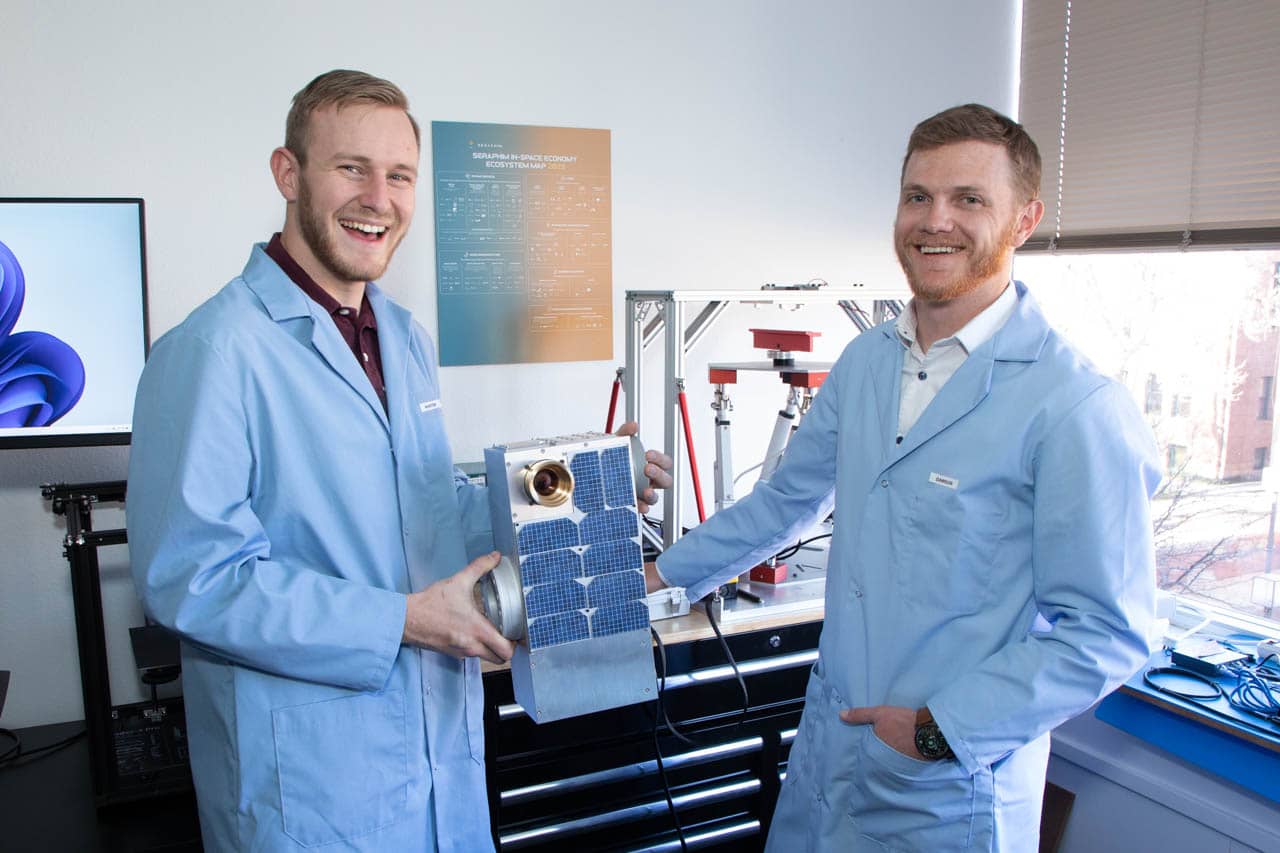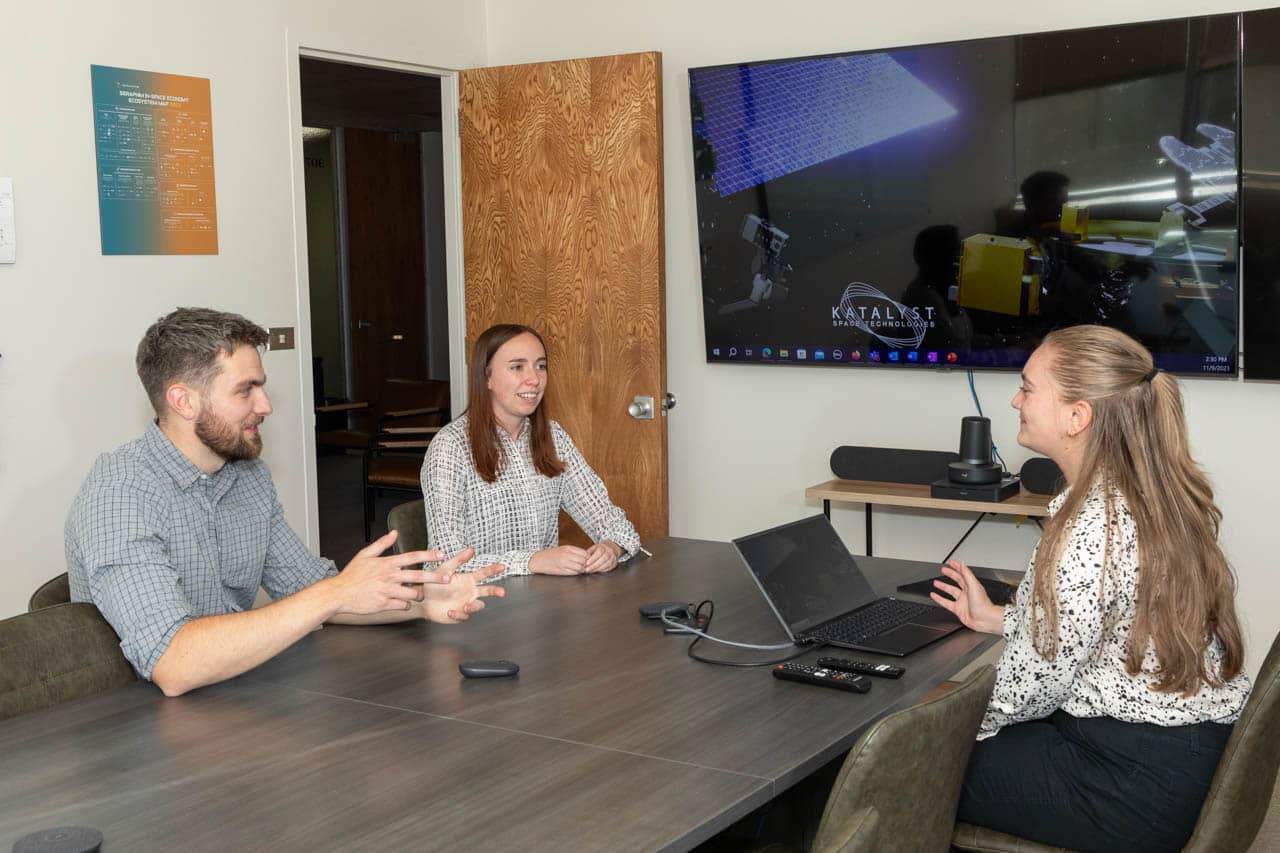A business model to change the space technology paradigm
It’s easy to think of space as some sort of “out there” place that doesn’t matter to the day to day lives of most people on earth. In reality, though, space technology is what makes our modern, device-driven lives possible. Satellites help us do remarkable things like monitor changes to the earth and its atmosphere or send television, phone, and internet signals. Much of Flagstaff’s history is also tied up with looking skyward, from the development of Lowell Observatory to the Apollo Moon mission trainings. Now, the team at Katalyst Space Technologies is extending Flagstaff’s legacy as a space-forward city by working to create a new paradigm for space technology.
Changing mindsets about space technology

According to Katalyst CEO, Ghonhee Lee, “Satellite designs are traditionally locked years before they launch. This means companies and governments make predictions about what the world will look like five to ten years into the future.” Building based on those predictions is an expensive gamble when many satellites cost around 1 billion dollars to make, and some satellite owners find that the technology they spent years and fortunes building is not in line with their needs once in orbit.
The team at Katalyst intends to change this “single-use” model, replacing it with an “upgrade economy” in which satellite operators would be able to add new features and capabilities by installing new hardware to satellites after they’ve launched. For Lee, this represents a change to the entire mindset of the creators of space technology. As he puts it, “We are bringing agile decision-making to space.”
So, how do you add new hardware to a satellite out in space? Right now, that answer is a little complicated. Think about the computer you use at home or work. That piece of technology is designed with ports (like USB ports) that allow you to plug in additional devices such as a mouse, keyboard, or webcam. Satellites, on the other hand, are not designed with ports or other mechanisms for adding hardware upgrades because until now, no such upgrades have existed.
“It’s a chicken or egg problem,” explains Sarah Bradley, Katalyst’s head of people and culture as well as its business development associate. What Katalyst has done to break this chicken or egg dilemma is create a self-contained device that attaches to the section of the satellite that was designed for the launch and delivery of the satellite into orbit. Katalyst’s novel attachment mechanism leverages this common satellite geometry to install new capabilities on orbit despite the satellite not being intended or designed to receive a post-launch enhancement.
Currently, the company is working on a space domain awareness (or SDA) device called SIGHT. SIGHT functions essentially the same way a Ring Doorbell does, using a camera sensor to record and communicate about the satellite’s immediate surroundings. This information can then help the satellite operators make better decisions about how to control or maneuver it. Katalyst’s software arm also plays a role here, creating artificial intelligence- or machine learning-enabled analytic tools to interpret data reported by SIGHT. This software allows operators to decipher and define specific kinds of satellites and debris through analyzing the light reflected from these objects over time. This awareness can help operators better manage space traffic in an increasingly congested environment.
 For Lee, SIGHT is more than just a useful satellite add-on. It is the first step in changing the entire satellite industry. “The impact space can have on humanity has been fundamentally limited by the launch-centric economy,” he explains, “While Earth-based exploration can use a diverse set of infrastructure—planes, helicopters, ships, trucks, electric drones, robots, etc.—space has had the same one-size fits all solution since Sputnik 1 in 1957.” Moving away from this launch-centric model, though, will allow satellite operators to, “pick the right tools for their mission at the right time.”
For Lee, SIGHT is more than just a useful satellite add-on. It is the first step in changing the entire satellite industry. “The impact space can have on humanity has been fundamentally limited by the launch-centric economy,” he explains, “While Earth-based exploration can use a diverse set of infrastructure—planes, helicopters, ships, trucks, electric drones, robots, etc.—space has had the same one-size fits all solution since Sputnik 1 in 1957.” Moving away from this launch-centric model, though, will allow satellite operators to, “pick the right tools for their mission at the right time.”
Finding the right partners and team members
Katalyst currently works primarily with the U.S. government, and much of its initial funding for research and development came through government grants. This is largely because when space exploration began, the world’s governments were in control of pretty much everything that happened in space. Recently, though, the U.S. has branched out, signaling an interest in working with commercial partners, and that is where entities like Katalyst come in.
Katalyst’s relationship with its government clients is not without its friction, though. Whereas Katalyst, as a small startup, is hyper aware of the need to be quick and agile so that it can get its products to market before its funding is depleted, the government entities it partners with are used to having more time to make and act on decisions, particularly those that involve major changes to their operations. This has required Katalyst to keep the pressure on, reminding its partners that time is an important factor if they are to move forward.
Katalyst is, of course, not limited to working with the government, and is in the process of expanding its reach to clients in other areas such as telecommunications. One challenge Lee notes that the business faces as it expands is in finding those willing to invest in “an emerging market with unvalidated business models.” Still, Lee is confident that the model Katalyst is creating will address the needs of “the modern world which requires faster decision making and more rapid iteration.”
At present, Katalyst is also in the process of transitioning from being primarily concerned with research and development, to being concerned with selling the product they’ve developed. According to Bradley that transition was something the business could have been better prepared for: “That’s something we realized the hard way in that we were, I think, really focusing on the day to day… because there’s so much on the to do list and we’re just trying to churn through all this stuff…” Eventually, the team realized it was also important to look at the big picture and to recognize that completing the product was not the end goal, but the beginning of their business’s journey.
This new sales-focused phase of the business also requires a different team with a different set of skills than the research and development phases did. Katalyst is in the process of hiring to build the team it needs, but as Lee notes, “The startup environment is rigorous, challenging, and exciting. It’s difficult finding the right fit.”
Building space technology in Flagstaff
When founded in 2020, Katalyst was fully remote, but the team found it had a need for more in-person collaboration and established a physical location in Flagstaff in 2021. According to Lee, Flagstaff was chosen because it allows employees to live in a place where they have a sense of community and access to an active lifestyle. Bradley says the location also helps to offset the stress that can come from the intensity of working at a startup. “I think it’s really important to be able to look out the window and see the mountains and just have that mountain air and the ponderosa pine and the butterscotch bark smell… I think it does alleviate some of that [stress].”
 Katalyst’s office is located in the downtown area, giving the team an opportunity to enjoy the local eateries together at lunch or in the evenings. Among their most frequented businesses are Hoot Mart, Aspen Deli, Drinking Horn Meadery, and Dark Sky Brewery.
Katalyst’s office is located in the downtown area, giving the team an opportunity to enjoy the local eateries together at lunch or in the evenings. Among their most frequented businesses are Hoot Mart, Aspen Deli, Drinking Horn Meadery, and Dark Sky Brewery.
In addition to the natural environment and meaningful community that the town provides, Katalyst has found support from the City of Flagstaff as a former member of the Moonshot program, and recipient of some of the grants it offers. Katalyst is particularly interested in engaging with the strong STEM community Flagstaff has fostered, and in contributing to the city’s economic development.
In the future, Lee hopes to build a spacecraft prototyping facility in Flagstaff. He explains that such a facility, “could be a game changer for our community, providing highly skilled jobs, collaboration space, and workforce development.” Lee admits that “it’s not the most pragmatic decision” to build such a facility in Flagstaff though, and is hoping to find common ground between Katalyst, the community, and the city that will help make it happen.
Advice for entrepreneurs
For those looking to start their own businesses, Lee recommends both self-reflection and community connection. To potential entrepreneurs, he says, “Consider what motivates you… be ready to fail repeatedly and have humility. Starting a business or being part of an early-stage startup team is all consuming.” He also recommends connecting with “others who have been on the road you are on or considering going down,” and relying on the power of that community. “Reach out,” he says, “Most people are willing to help.”




